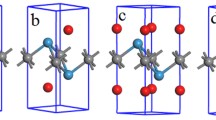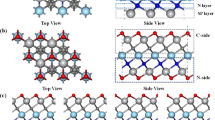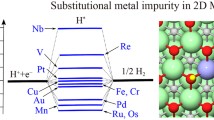Abstract
Currently, finding the non-precious metal catalyst for hydrogen evolution reaction (HER) is significant and urgent. By performing the first-principles calculations, we studied the structural and electronic properties, as well as the catalytic activity of MXenes Mn+1CnO2 (n = 1, 2; M = Sc, Ti, V, Cr, Mn, Zr, Nb, Mo, Hf, Ta and W) toward HER. These 22 MXenes are metallic except for Sc2CO2, Ti2CO2, Mn2CO2, Zr2CO2 and Hf2CO2 which are semiconducting. By calculating the Gibbs free energy change (ΔGH) for H adsorption which is the simple but effective descriptor for HER catalytic activity, and analyzing the electrical conductivity, we find that Nb2CO2, W2CO2, Zr3C2O2 and W3C2O2 are catalytic active for HER at low H coverage. Particularly, Nb2CO2 and Zr3C2O2 maintain to be active for catalyzing HER under tensile strain less than 5%. And Nb3C2O2 shows enhanced catalytic activity for HER under 3–5% tensile strain. Additionally, the differential ΔGH and average ΔGH were used to evaluate the HER catalytic activity at high H coverage (1/8–6/8). Our calculations show that Nb2CO2 is active for HER at H coverage less than 3/8. Plus, V2CO2, Ti3C2O2 and Cr3C2O2 demonstrate the catalytic activity for HER at high H coverage.








Similar content being viewed by others
References
Dresselhaus M, Thomas I (2001) Alternative energy technologies. Nature 414:332–337
Turner JA (2004) Sustainable hydrogen production. Science 305:972–974
Chu S, Majumdar A (2012) Opportunities and challenges for a sustainable energy future. Nature 488:294–303
Hosseini SE, Wahid MA (2016) Hydrogen production from renewable and sustainable energy resource: promising green energy carrier for clean development. Renew Sust Energy Rev 57:850–866
Gressley J, Jarmaillo TF, Bonde J, Chorkendorff I, Nørskov JK (2006) Computational high-throughput screening of electrocatalytic materials for hydrogen evolution. Nat Mater 5:909
Zou XX, Zhang Y (2015) Noble metal-free hydrogen evolution catalysts for water splitting. Chem Soc Rev 44:5148–5180
Zhen Y, Jiao Y, Jaroniec M, Qiao SZ (2015) Advancing the electrochemistry of the hydrogen-evolution reaction through combing experiment and theory. Angew Chem Int Ed 54(1):52–65
Seh ZW, Fredrickson KD, Anasori B, Kibsgaard J, Strickler AL, Lukatskaya MR, Gogotsi Y, Jaramillo TF, Vojvodic A (2016) Two-dimensional molybdenum carbide (MXene) as an efficient electrocatalyst for hydrogen evolution. ACS Energy Lett 1(3):589–594
Ran JR, Gao GP, Li FT, Ma TY, Du AJ, Qiao SZ (2017) Ti3C2 MXene Co-catalyst on metal sulfide photo-absorbers for enhanced visible-light photocatalytic hydrogen production. Nat Commun 8:13907
Ling CY, Li S, Ouyang YX, Wang JL (2016) Searching for highly active catalysts for hydrogen evolution reaction based on O-terminated MXenes through a simple descriptor. Chem Mater 28(24):9026–9032
Jiang W, Zou XL, Du HD, Gan L, Xu CJ, Kang FY, Duan WH, Li J (2018) Universal descriptor for large-scale screening of high-performance MXene-based materials for energy storage and conversion. Chem Mater 30(8):2687–2693
Pandey M, Thygesen KS (2017) Two-dimensional MXenes as catalysts for electrochemical hydrogen evolution; a computational screening study. J Phys Chem C 121(25):13593–13598
Gao GP, O’Mullane AP, Du AJ (2017) 2D MXenes: a new family of promising catalysts for the hydrogen evolution reaction. ACS Catal 7(1):494–500
Hinnemann B, Moses PG, Bonde J, Jørgensen KP, Nielsen JH, Horch S, Chorkendorff I, Nørskov JK (2015) Biomimetic hydrogen evolution: MoS2 nanoparticles as catalyst for hydrogen evolution. J Am Chem Soc 127(15):5308–5309
Nørskov JK, Bligaard T, Logadottir A, Kitchin JR, Chen JG, Pandelov S, Stimming U (2015) Trends in the exchange current for hydrogen evolution. J Electrochem Soc 152(3):J23–J26
Jaramillo TF, Jørgensen KP, Bonde J, Nielsen JH, Horch S, Chorkendorff I (2017) Identification of active edge sites for electrochemical H2 evolution from MoS2 nanocatalysts. Science 317(5834):100–102
Lukowski MA, Daniel AS, Meng F, Forticaux A, Li LS, Jin S (2013) Enhanced hydrogen evolution catalysis from chemically exfoliated metallic MoS2 nanosheets. J Am Chem Soc 135(28):10274–10277
Voiry D, Yamaguchi H, Li JW, Silva R, Alves DC, Fujita T, Chen MW, Asefa T, Shenoy VB, Eda G, Chhowalla M (2013) Enhanced catalytic activity in strained chemically exfoliated WS2 nanosheets for hydrogen evolution. Nat Mater 12:850–855
Li YG, Wang HL, Xie LM, Liang YY, Hong GS, Dai HJ (2011) MoS2 nanoparticles grown on graphene: an advanced catalyst for the hydrogen evolution reaction. J Am Chem Soc 133(19):7296–7299
Kibsgaard J, Chen ZB, Reinecke BN, Jaramillo TF (2012) Engineering the surface structure of MoS2 to preferentially expose active edge sites for electrocatalysis. Nat Mater 11:963–969
Xie JF, Zhang H, Li S, Wang RX, Sun X, Zhou M, Zhou JF, Lou XW, Xie Y (2013) Defect-rich MoS2 ultrathin nanosheets with additional active edge sites for enhanced electrocatalytic hydrogen evolution. Adv Mater 25(40):5807–5813
Xie JF, Zhang JJ, Li S, Grote F, Zhang XD, Zhang H, Wang RX, Lei Y, Pan BC, Xie Y (2013) Controllable disorder engineering in oxygen-incorporated MoS2 ultrathin nanosheets for efficient hydrogen evolution. J Am Chem Soc 135(47):17881–17888
Fan XL, Yang Y, Xiao P, Lau WM (2014) Site-specific catalytic activity in exfoliated MoS2 single-layer polytypes for hydrogen evolution: basal plane and edges. J Mater Chem A 2:20545–20551
An YR, Fan XL, Luo ZF, Lau WM (2016) Nanopolygons of monolayer MS2: best morphology and size for HER catalysis. Nano Lett 17(1):368–376
Liang HF, Shi HH, Zhang DF, Ming FW, Wang RR, Zhuo JQ, Wang ZC (2016) Solution growth of vertical VS2 nanoplate arrays for electrocatalytic hydrogen evolution. Chem Mater 28(16):5587–5591
Naguib M, Mashtalir O, Carle J, Presser V, Lu J, Hultman L, Gogotsi Y, Barsoum MW (2012) Two-dimensional transition metal carbides. ACS Nano 6(2):1322–1331
Naguib M, Mochalin VN, Barsoum MW, Gogotsi Y (2014) 25th Anniversary article: MXenes: a new family of two-dimensional materials. Adv Mater 26:992–1005
Naguib M, Kurtoglu M, Presser V, Lu J, Niu JJ, Heon M, Hultman L, Gogotsi Y, Barsoum MW (2011) Two-dimensional nanocrystals produced by exfoliation of Ti3AlC2. Adv Mater 23:4248–4253
Zhou J, Zha XH, Chen FY, Ye Q, Eklund P, Du SY, Huang Q (2016) Two-dimensional zirconium carbide by selective etching of Al3C3 from nanolaminated Zr3Al3C5. Angew Chem 128:5092–5097
Ashton M, Henning RG, Broderick SR, Rajan K, Sinnott SB (2016) Computational discovery of stable M2AX phases. Phys Rev B 94(5):054116
Dall’Agnese Y, Taberna PL, Gogotsi Y, Simon P (2015) Two-dimensional vanadium carbide (MXene) as positive electrode for sodium-ion capacitors. J Phys Chem Lett 6(12):2305–2309
Meshkian R, Tao QZ, Dahlqvist M, Lu J, Hultman L, Rosen J (2017) Theoretical stability and materials synthesis of a chemically ordered MAX phase, Mo2ScAlC2, and its two-dimensional derivate Mo2ScC2 MXene. Acta Mater 125:476–480
Naguib M, Halim J, Lu J, Kevin MC, Lars H, Gogotsi Y, Barsoum MW (2013) New two-dimensional niobium and vanadium carbides as promising materials for Li-ion batteries. J Am Chem Soc 135(43):15966–15969
Tang X, Guo X, Wu WJ, Wang GX (2018) 2D metal carbides and nitrides (MXenes) as high-performance electrode materials for lithium-based batteries. Adv Energy Mater 8(33):1801897
Xu C, Wang LB, Liu ZB, Chen L, Guo JK, Ma XL, Cheng HM, Ren WC (2015) Large-area high-quality 2D ultrathin Mo2C superconducting crystals. Nat Mater 14:1135–1141
Huang H, Wu HH, Chi C, Huang BL, Zhang TY (2019) Ab initio investigations of orthogonal ScC2 and ScN2 monolayers as promising anode materials for sodium-ion batteries. J Mater Chem A 7:8897–8904
Lukatskaya MR, Mashtalir O, Ren CE, Dall’Agnese Y, Rozier P, Taberna PL, Naguib M, Simon P, Barsoum MW, Gogotsi Y (2013) Cation intercalation and high volumetric capacitance of two-dimensional titanium carbide. Science 341(6153):1502–1505
Rakhi RB, Ahmed B, Hedhili MN, Anjum DH, Alshareef HN (2015) Effect of postetch annealing gas composition on the structural and electrochemical properties of Ti2CTx MXene electrodes for supercapacitor applications. Chem Mater 27(15):5314–5323
Anasori B, Lukatskaya MR, Gogotsi Y (2017) 2D metal carbides and nitrides (MXenes) for energy storage. Nat Rev Mater 2:16098
Xie Y, Naguib M, Mochalin V, Barsoum MW, Gogotsi Y, Yu X, Nam KW, Yang KQ, Kolesnikov AI, Kent PRC (2014) Role of surface structure on Li-ion energy storage capacity of two-dimensional transition-metal carbides. J Am Chem Soc 135(17):6385–6394
Li NB, Wei ST, Xu YC, Liu J, Wu JD, Jia GR, Cui XQ (2018) Synergetic enhancement of oxygen evolution reaction by Ti3C2Tx nanosheets supported amorphous FeOOH quantum dots. Electrochim Acta 290:364–368
Kresse G, Furthmüller J (1996) Efficiency iterative schemes for ab initio total-energy calculations using a plane-wave basis set. Phys Rev B Condens Matter Mater Phys 54(16):11169–11186
Kresse G, Joubert D (1999) From ultrasoft pseudopotentials to the projector augmented-wave method. Phys Rev B Condens Matter Mater Phys 59(3):1758–1775
Perdew JP, Burke K, Ernzerhof M (1996) Generalized gradient approximation made simple. Phys Rev Lett 77(18):3865–3868
Grimme S (2006) Semiempirical GGA-type density functional constructed with a long-range dispersion correction. J Comput Chem 27:1787–1799
Monkhorst HJ, Pack JD (1976) Special points for brillouin-zone integrations. Phys Rev B 13(12):5188–5192
Greely J, Jaramillo TF, Bonde J, Chorkendorff I, Nørskov JK (2006) Computational high-throughput screening of electrocatalytic materials for hydrogen evolution. Nat Mater 5:909–913
Nørskov JK, Bligaard T, Logadottir A, Kitchin JR, Chen JG, Pandelov S, Stimming U (2005) Trends in the exchange current for hydrogen evolution. J Electrochem Soc 152(3):J23–J26
Irikura KK (2007) Experimental vibrational zero-point energies: diatomic molecules. J Phys Chem Ref Data 36(2):389–397
Campbell CT, Sellers JRV (2012) The entropies of adsorbed molecules. J Am Chem Soc 134(43):18109–18115
Budi A, Stipp SLS, Andersson MP (2018) Calculation of entropy of adsorption for small molecules on mineral surfaces. J Phys Chem C 122(15):8236–8243
Fu ZH, Zhang QF, Legut D, Si C, Germann TC, Lookman T, Du SY, Francisco JS, Zhang RF (2016) Stabilization and strengthening effects of functional groups in two-dimensional titanium carbide. Phys Rev B 94(10):104103
Fu ZH, Zhang H, Si C, Legut D, Germann TC, Zhang QF, Du SY, Francisco JS, Zhang RF (2018) Mechanistic quantification of thermodynamic stability and mechanical strength for two-dimensional transition-metal carbides. J Phys Chem C 122(8):4710–4722
Yu S, Rao YC, Wu HH, Duan XM (2018) C2N: an excellent catalyst for the hydrogen evolution reaction. Phys Chem Chem Phys 20:27970–27974
Acknowledgement
This work was supported by the National key R&D Program of China (2018YFB0703800) and the Natural Science Fund of Shaanxi Province for distinguished Yong Scholars (2019JC-10).
Author information
Authors and Affiliations
Corresponding author
Additional information
Publisher's Note
Springer Nature remains neutral with regard to jurisdictional claims in published maps and institutional affiliations.
Rights and permissions
About this article
Cite this article
Ma, S., Fan, X., An, Y. et al. Exploring the catalytic activity of MXenes Mn+1CnO2 for hydrogen evolution. J Mater Sci 54, 11378–11389 (2019). https://doi.org/10.1007/s10853-019-03712-4
Received:
Accepted:
Published:
Issue Date:
DOI: https://doi.org/10.1007/s10853-019-03712-4




